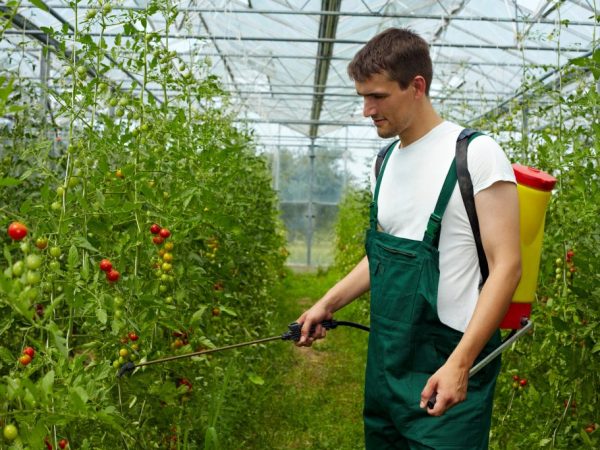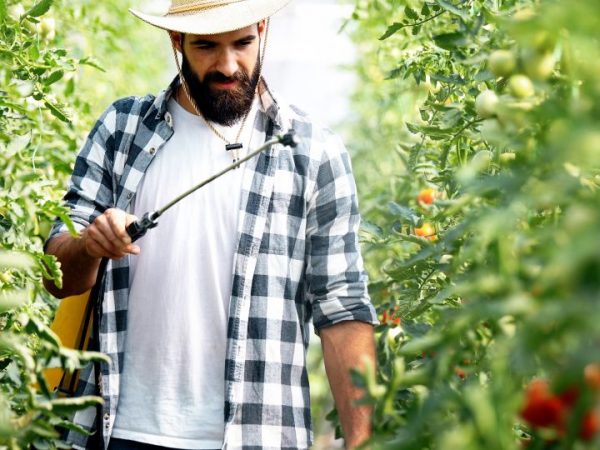Application of fungicides for tomatoes
Fungicides for tomatoes are special products that help summer residents save tomato crops in rainy seasons, when there is a peak of diseases and infections.

Application of fungicides for tomatoes
Appointment of fungicides and their varieties
The main purpose of fungicidal complexes is to effectively combat diseases of fungal and bacterial origin common among vegetable crops.
Division by composition
Depending on the components that make up the fungicidal preparations for tomatoes, they are divided into:
- inorganic, of a chemical nature, often among the components you can find copper, sulfur salts, iron and other chemical micro- and macroelements and compounds;
- organic, including morpholines, phthalimides, triazoles, carbamates and other organic compounds;
- biological, developed on the basis of fungi and bacteria, as well as including a variety of plant extracts.
Division by appointment
All groups of fungicidal compositions can be used both in combination and in relation to each object separately. Including there:
- preparations for disinfection of seed material;
- antiseptic complexes and compositions with antibiotics for substrates;
- drugs with a cumulative effect, used during the dormant period of plants, for example, in winter;
- compositions used for seedlings and adult plants at different stages of their growth and development.
The principle of action and functions of fungicides
By the nature of the effect on bacterial and fungal diseases affecting plants, fungicides for tomatoes are of several varieties:
- Contact. They are sprayed on all plantings as a whole, their main task is to create protection for tomato plants as a whole. They act by contacting infections and fungi with the treated vegetative parts of plants.
- Systemic. Such fungicidal preparations are absorbed through the vegetation and enter the conductive system of the vegetable crop, circulating inside it along with the vegetable juices.
When choosing fungicides for tomatoes, it should be borne in mind that not all of them retain their effect when used together with other drugs. They remain active together with insecticides and fertilizers of the combined group.
Tatiana Orlova (Candidate of Agricultural Sciences):
A frequent question among amateur gardeners: which fungicide preparations can be mixed with insecticide preparations? those. to simultaneously combat diseases and pests? There are special tables of compatibility of drugs, but the general rules are the following: chemical drugs are mixed only with chemical ones. They cannot be mixed with either biological or organic.
Protective fungicidal compositions act in different ways:
- destroy the cell centers of microorganisms, block the division of their nuclei;
- have a stimulating effect on vegetable crops, increasing the level of phytoalexins production;
- create necrotic protection for unaffected vegetable tissue;
- have a destabilizing effect on cell membranes, stopping the production of ergosterol;
- stop the synthesis of acidic compounds from the nucleic group in bacteria and fungi;
- disrupt energy metabolism in microorganisms.
In order to preserve the effectiveness of the action of fungicidal complexes, it is recommended to alternate. This avoids the emergence of resistance to systemic drugs.
Tatiana Orlova (Candidate of Agricultural Sciences):
During the season (depending on weather conditions), up to 6-8 treatments with drugs - fungicides can be carried out. In this case, contact drugs are alternately used, for example, Bordeaux liquid and systemic ones, for example Thanos.
Application procedure

Stick to the rules
There are a number of general rules for the use of any of the compositions that make up the fungicides for tomatoes.
Seed material
Seeds are treated with fungicidal complexes in summer or autumn, after they are harvested and finally dried. Planting material is soaked in solutions or pollinated with dry mixtures.
Saplings
Seedlings are treated with drugs just before they are transplanted into soil.
The soil
The soil is treated with fungicides in the fall, immediately after harvesting and cleaning the site from plant residues. The introduction of fungicidal preparations in the spring, immediately before planting tomato seedlings, delays their growth and development and increases the growing season.
Tatiana Orlova (Candidate of Agricultural Sciences):
If, for some reason, soil disinfection was not carried out in the fall, as required, and there is a likelihood of a recurrence of the disease, then the soil can be treated with a biological fungicide, for example Fitosporin. However, this must also be done not at the time of planting, but 1-1.5 weeks before that.
Timing and frequency
The timing and frequency of using fungicides for tomatoes is indicated in the instructions. They directly depend on the agent used, the stage of development of the tomatoes and the regional conditions in which the vegetable crop is grown. Usually contact complexes create protection for 1.5-2 weeks in dry weather. For systemic agents, the duration of protection is longer and is about 3 weeks.
Extraordinary treatment is carried out immediately upon detection of primary signs of disease.
Recommended remedies
Among the fungicides for tomatoes, there are a number of complexes that have proven to be effective means.
Quadris
The systemic composition of the new generation of Quadris has a wide range of effects and can create protection for tomato plantings from most diseases typical of vegetable crops. It belongs to a new series of fungicidal agents - Strobilurins. It is effective against late blight, powdery and downy mildew, spotting.
Acrobat MC
Acrobat MC is effective in combating late blight, as well as a number of other fungal diseases of tomato: black spot and macrosporiosis.
Ridomil
The systemic fungicide Ridomil, which has the character of contact action, is easy to use and effectively helps against late blight and Alternaria. It can be combined with other products.
Agate
The complex of biological origin Agate is intended for processing seed material in order to create protection for it and increase its resistance against bacterial and fungal infections.
Bordeaux mixture
Bordeaux mixture is a contact agent known among gardeners that effectively protects tomatoes from fungal infections. It also helps fight diseases common in tomatoes.
Strobe
The systemic fungicide Strobi has been shown to be effective against various types of fungi.According to the instructions, strobe refers to complexes used to protect grapes, apple trees and pears, but gardeners use it effectively when growing tomatoes, as it protects tomatoes from powdery mildew and late blight.
Tatiana Orlova (Candidate of Agricultural Sciences):
The Strobi drug is one of the most effective against various fungal pathogens on both vegetable and fruit crops. But it should be used no more than 1 time per summer, so that the causative agents of the infection do not quickly become addicted to it.



